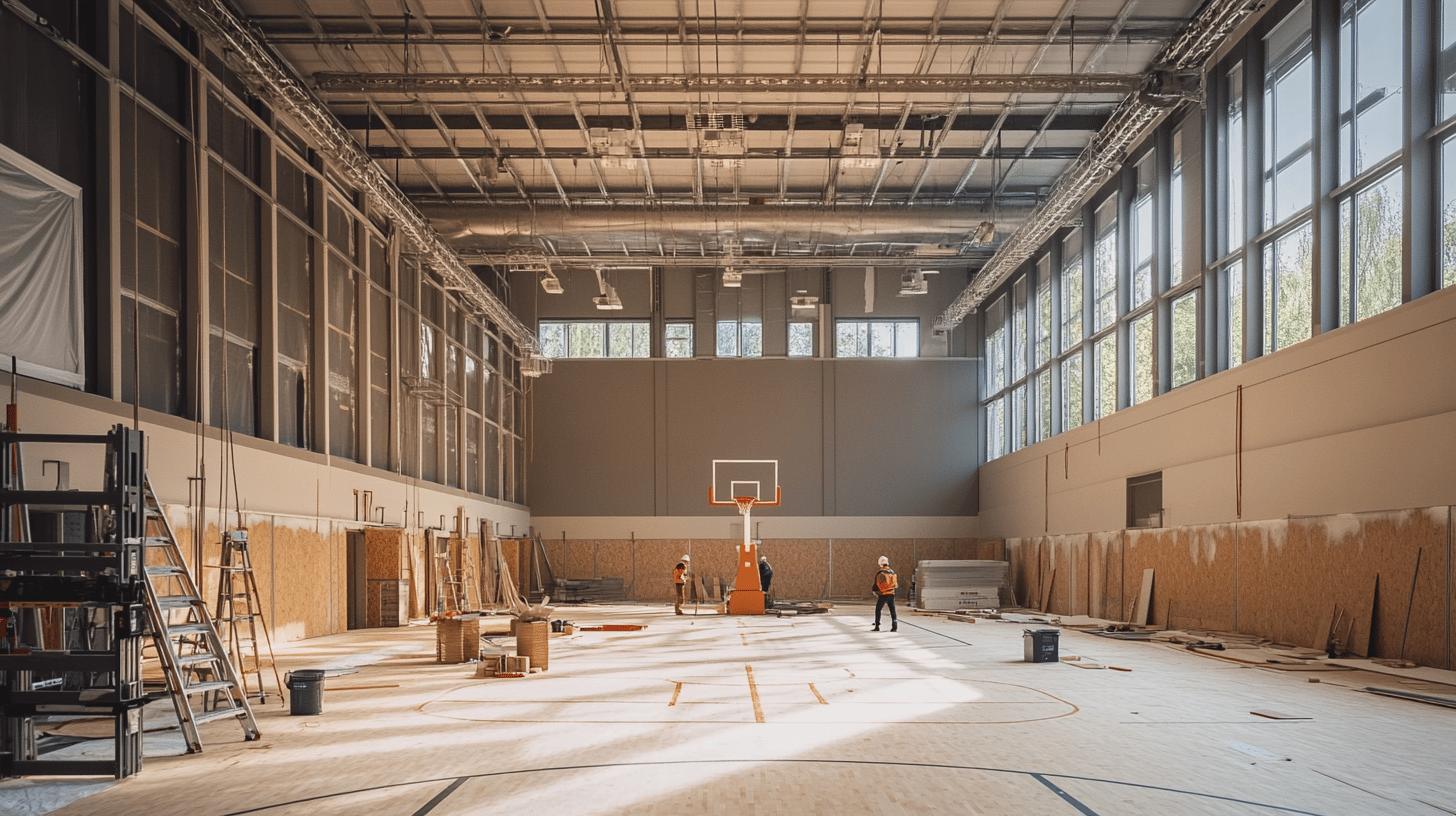So, your hall floor’s taken a bit of a beating from a flood, eh? It’s a proper nightmare, I know. One minute everything’s fine, the next you’re wading through water, wondering what on earth to do. The key thing with this kind of mess is to get on it super fast. We’re talking about stopping things getting even worse, protecting your stuff, and making sure your place gets back to normal as quickly as possible. This article’s all about how to handle those tricky flood-damaged hall floors, from the first splash to getting everything sorted.
Key Takeaways
- Act fast when water hits to stop more damage and keep everyone safe.
- Understand how water messes with floors and why mould is a big worry.
- Get the pros in; they’ve got the right gear and know-how for a proper fix.
- Keep good records for your insurance and to avoid future headaches.
- Quick action means less hassle for your business and keeps your good name intact.
.
Immediate Emergency Response Protocols
When a hall floor suffers flood damage, time is of the essence. A swift, well-coordinated response can dramatically reduce the extent of the damage and the associated costs. It’s not just about mopping up water; it’s about understanding the potential hazards and acting decisively.
Prioritising Safety and Hazard Assessment
First and foremost, safety is paramount. Before entering a flooded hall, assess the risks. Are there any electrical hazards? Is the structure sound? Turn off the electricity supply to the affected area if it’s safe to do so. Be aware of slippery surfaces and potential trip hazards. Contact emergency services if the situation is beyond your capabilities. Remember, your well-being is the top priority. If you are unsure about safe sports hall floors, call a professional.
Swift Water Removal Strategies
Once the area is deemed safe, begin removing the water as quickly as possible. The longer water sits, the more damage it causes. Use pumps, wet vacuums, and mops to extract standing water. Focus on the areas where water is pooling. Consider the following:
- Start with the lowest points in the hall.
- Use submersible pumps for large volumes of water.
- Ensure proper ventilation to aid drying.
.
Quick action is key. Every hour counts when dealing with floodwater. The faster you remove the water, the less chance there is of lasting damage and mould growth.
Protecting Valuables and Contents
Alongside water removal, protect any valuables or contents that can be salvaged. Move furniture to dry areas, elevate items off the floor, and cover them with waterproof sheeting. Document the condition of items before moving them for insurance purposes. Consider professional help for water damage restoration of sensitive items.
Here’s a simple table to guide your actions:
| Item | Action |
|---|---|
| Furniture | Move to dry area, elevate if possible |
| Electronics | Disconnect and move to dry area |
| Documents | Place in waterproof containers |
| Valuables | Secure and document condition |
Understanding Flood Damage to Hall Floors

Rapid Onset of Water Damage Effects
Floodwater acts fast. Hall floors, especially those made of wood or laminate, can show signs of damage within hours. Absorption leads to swelling, warping, and delamination. The type of water (clean, grey, or black) also affects the speed and severity of the damage. Clean water is less immediately harmful, but grey or black water introduces contaminants that accelerate deterioration and pose health risks. It’s a race against time to mitigate these initial effects.
Risks to Structural Integrity
Beyond surface damage, floodwater can compromise the structural integrity of hall floors. Subfloors, joists, and supporting structures are all vulnerable. Prolonged exposure weakens these elements, potentially leading to sagging, instability, and even collapse. The weight of absorbed water adds extra stress. Regular inspections are vital to catch these issues early. If the damage is severe, you might need sports hall flooring refurbishment.
Preventing Mould and Mildew Proliferation
Mould and mildew are common consequences of flood damage. These fungi thrive in damp, dark environments, and hall floors provide ideal breeding grounds. Mould not only damages the floor itself but also poses significant health risks, especially for those with allergies or respiratory problems. Effective drying and dehumidification are crucial to prevent mould growth.
Prompt action is key. The longer water remains, the greater the risk of mould and structural damage. Addressing the problem within 24-48 hours significantly improves the chances of successful remediation.
Here’s a quick guide to drying times:
| Material | Drying Time (Approximate) | Notes |
|---|---|---|
| Wood Flooring | 2-4 weeks | Depends on thickness and ventilation |
| Concrete Subfloor | 4-6 weeks | Requires thorough dehumidification |
| Carpet | 1-3 weeks | Often needs professional cleaning |
Professional Emergency Repairs and Remediation
Right, so you’ve had a flood. It’s awful, but what happens now? Getting the professionals in is the next logical step. They’ll handle the stuff you simply can’t, or shouldn’t, do yourself. Think of it as damage control, but with actual control.
Specialist Equipment and Techniques
These aren’t your average DIY tools. We’re talking industrial-strength dehumidifiers, thermal imaging cameras, and extraction units that could probably suck the water out of a swimming pool in minutes. Specialist firms use these to get to the root of the problem, drying out hidden moisture and preventing long-term issues like mould growth. They also know how to use them properly, which is half the battle. It’s not just about having the kit; it’s about knowing what settings to use, where to focus the effort, and how to monitor progress.
Post-Remediation Protocols
Once the water’s gone, it’s not job done. There’s a whole load of cleaning, sanitising, and testing to be done. This is where the pros really earn their money. They’ll use antimicrobial treatments to kill off any lingering bacteria, check for hidden damp, and make sure the air quality is safe.
Here’s a quick rundown of what to expect:
- Thorough cleaning of all affected surfaces.
- Application of antimicrobial treatments.
- Air quality testing to ensure safety.
- Moisture level monitoring to prevent future problems.
- Deodorisation to remove any lingering smells.
.
Comprehensive Build-Back Services
Okay, so the floor’s dry, clean, and safe. But it’s probably still a mess. This is where the ‘build-back’ comes in. It’s the process of putting everything back together – replacing damaged flooring, repairing walls, and generally making the place habitable again. A good remediation company will offer this as part of their service, so you don’t have to deal with multiple contractors.
Getting your hall floor back to normal after a flood is a multi-stage process. It starts with the emergency response, moves through the drying and cleaning phase, and ends with the build-back. Each stage requires specialist knowledge and equipment, so it’s best left to the professionals. Trying to cut corners could end up costing you more in the long run.
Documentation for Insurance and Compliance
Cataloguing Photo Evidence
When disaster strikes, getting your insurance sorted is a top priority. That’s why taking photos is so important. Make sure you document everything before any cleanup begins. Get wide shots, close-ups, and anything that shows the extent of the damage. It’s also a good idea to keep a written log alongside the photos, noting the date, time, and a brief description of each image. This will help jog your memory later and provide a clear record for your insurance company.
Detailed Data Reports and Readings
Beyond photos, detailed data is key. This means getting moisture readings, humidity levels, and any other relevant environmental data. Professionals use specialist equipment to gather this information, which can be crucial in determining the extent of the damage and the necessary repairs.
Here’s a simple example of how data might be presented:
| Location | Moisture Reading (%) | Humidity (%) |
|---|---|---|
| Hall Floor | 25 | 70 |
| Adjacent Wall | 18 | 65 |
| Underlay | 35 | 75 |
This kind of data helps paint a clearer picture for insurers and helps justify the sports flooring inspection and repair work needed.
EHS Compliance and Future Liability Protection
It’s not just about getting the insurance sorted; it’s also about protecting yourself from future problems. Make sure all work is carried out in compliance with Environmental Health and Safety (EHS) regulations. This includes things like proper disposal of contaminated materials and ensuring the work area is safe for everyone. Keeping records of this compliance can protect you from potential liability down the line.
Proper documentation isn’t just about getting your claim approved; it’s about ensuring the safety of your property and protecting yourself from future legal issues. It’s an investment in peace of mind.
Minimising Business Disruption

Flood damage to a hall floor can really throw a spanner in the works for any business. It’s not just about the immediate damage; it’s about the knock-on effects that can grind operations to a halt. Getting things back up and running quickly is essential to minimise losses and maintain a good reputation. Here’s how to tackle it:
Reducing Company Downtime
Downtime is a killer. Every hour spent dealing with flood damage is an hour not spent serving customers or making money. The key is to act fast. Have a plan in place, know who to call, and get the ball rolling on repairs as soon as it’s safe to do so. This might mean temporarily relocating certain operations or implementing remote working solutions, but the goal is to keep things moving as much as possible.
Avoiding Costly Restorations
The longer you leave water damage, the worse it gets, and the more expensive it becomes to fix. Early intervention can prevent minor issues from escalating into major structural problems. This includes things like:
- Prompt water extraction.
- Thorough drying and dehumidification.
- Addressing any mould growth immediately.
.
By tackling the problem head-on, you can avoid the need for extensive and costly renovations down the line. It’s an investment that pays off in the long run.
Protecting Business Reputation
No one wants to deal with a business that’s visibly damaged or perceived as unsafe. Flood damage can create a negative impression, leading to loss of customers and damage to your brand. Quick and effective repairs demonstrate that you’re responsible and care about your customers’ experience. Clear communication is also important – keep your customers informed about the situation and what you’re doing to resolve it. This can help maintain trust and minimise any negative impact on your reputation.
Real-Life Emergency Repairs Successes
Effective Home Flood Mitigation
We’ve all seen the horror stories – homes devastated by floods. But sometimes, quick thinking and the right action can make all the difference. Take Mrs. Higgins, for example. A burst pipe flooded her downstairs hall floor while she was out shopping. Luckily, a neighbour spotted the water seeping under the front door and called us immediately. Our rapid response team was on-site within the hour. We managed to extract the water, dry the area, and prevent any lasting structural damage. Mrs. Higgins was back in her home within days, with minimal disruption. It’s a testament to how crucial a fast response is in these situations. We were able to provide effective sports hall flooring maintenance to ensure the floor was safe.
Rapid Response to Burst Pipes
Burst pipes are a common cause of hall floor damage, especially during the colder months. One particularly memorable case involved a commercial property where a pipe burst on the second floor, causing water to cascade down through the building, affecting the hall floors on multiple levels. The key to our success was the speed of our response. We quickly isolated the water source, preventing further damage. Then, we used specialist equipment to extract the water and dry the affected areas. The result? The business was able to reopen within 48 hours, avoiding significant financial losses.
Timely Actions Limiting Damage
It’s not always about dealing with major disasters; sometimes, it’s the small, timely actions that make the biggest difference. Consider the case of Mr. Davies, who noticed a small leak under his sink. He initially ignored it, thinking it was insignificant. However, after a few days, he realised the hall floor nearby was starting to warp. He called us, and we were able to identify and fix the leak quickly. More importantly, we were able to dry the floor and prevent any further warping or mould growth. This highlights the importance of addressing even minor water damage issues promptly.
Prevention is always better than cure. Regular maintenance checks and prompt action when you spot a problem can save you a lot of time, money, and stress in the long run.
Here are some key takeaways from these real-life successes:
- Speed is essential: The faster you respond to water damage, the less damage it will cause.
- Professional help is invaluable: Specialist equipment and expertise can make all the difference.
- Prevention is key: Regular maintenance and prompt action can prevent major disasters.
.
Developing an Emergency Response Plan
It’s easy to think that a flood will never happen to you, but the truth is, it can happen to anyone. That’s why having a plan in place is so important. No one wants to think about a disaster negatively affecting their business, but having a water remediation plan in place for when a water emergency occurs is crucial for any commercial business.
Formulating a Proactive Strategy
Think about what could go wrong. What are the most likely causes of flooding in your area? Is it burst pipes, heavy rain, or something else? Once you know the risks, you can start to put together a plan. This should include things like:
- Who to contact in an emergency
- Where to find important documents
- How to shut off the water supply
- Evacuation routes
.
It’s a good idea to practise your plan regularly, so everyone knows what to do in an emergency. This could involve running drills or simply talking through the steps.
Ensuring Rapid Treatment of Surfaces
Time is of the essence when it comes to water damage. The longer water sits, the more damage it can cause. That’s why it’s important to act quickly to remove water and dry out surfaces. This might involve:
- Using pumps to remove standing water
- Opening windows and doors to ventilate the area
- Using fans and dehumidifiers to dry out surfaces
- Applying antimicrobial treatments to prevent mould growth
.
Accessing Certified Specialists
While you can do some things yourself, it’s often best to call in the professionals. Certified water damage restoration specialists have the training and equipment to handle even the most complex situations. They can also help you with things like:
- Assessing the extent of the damage
- Developing a restoration plan
- Working with your insurance company
- Ensuring that the property is safe and habitable
.
Crafting a solid emergency plan is super important for keeping everyone safe. It means thinking ahead about what to do if something bad happens. To learn more about how to make your own plan, check out our website.
Wrapping Up
So, there you have it. Dealing with flood-damaged hall floors can feel like a huge headache, but with a bit of quick thinking and the right steps, you can really cut down on the damage. Remember, acting fast is key. Getting the water out, drying things properly, and then deciding what needs fixing or replacing can save you a lot of bother down the line. It’s all about being prepared and knowing what to do when disaster strikes. And if it all feels a bit much, don’t be afraid to call in the pros; they’ve got the gear and the know-how to get your floors back to normal.
Call 24-hour repairs → Contact
Frequently Asked Questions
Why is it so important to act quickly when there’s water damage?
It’s really important to act fast! Water damage can spread quickly, causing problems like warped floors, ruined furniture, and even mould. The sooner you deal with it, the less damage there will be, and the easier it will be to fix.
What should I do first if my hall floor gets flooded?
First, make sure everyone is safe. If there’s a lot of water or electrical hazards, call emergency services right away. Then, try to stop the water source if you can, and move important items to a dry place. You can use mops or wet-dry vacuums to remove water.
How does water damage affect hall floors?
Water can make floors swell, buckle, and even rot over time. It can also weaken the structure of your building. Plus, damp conditions are perfect for mould and mildew to grow, which can be bad for your health.
Should I take pictures of the damage for insurance?
Yes, it’s a good idea! Taking photos of the damage and keeping records of everything you do to fix it will help a lot when you talk to your insurance company. It proves what happened and what steps you took.
How can professional help reduce problems for my business?
Getting professionals involved helps a lot. They have special tools to dry things out properly and can spot hidden damage. This saves you money in the long run by preventing bigger problems and getting your business back to normal faster.
Why is having an emergency plan important for water damage?
Having a plan ready means you know exactly what to do when water damage happens. This helps you react quickly, get the right people to help, and stop the damage from getting worse, which saves time and money.


